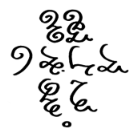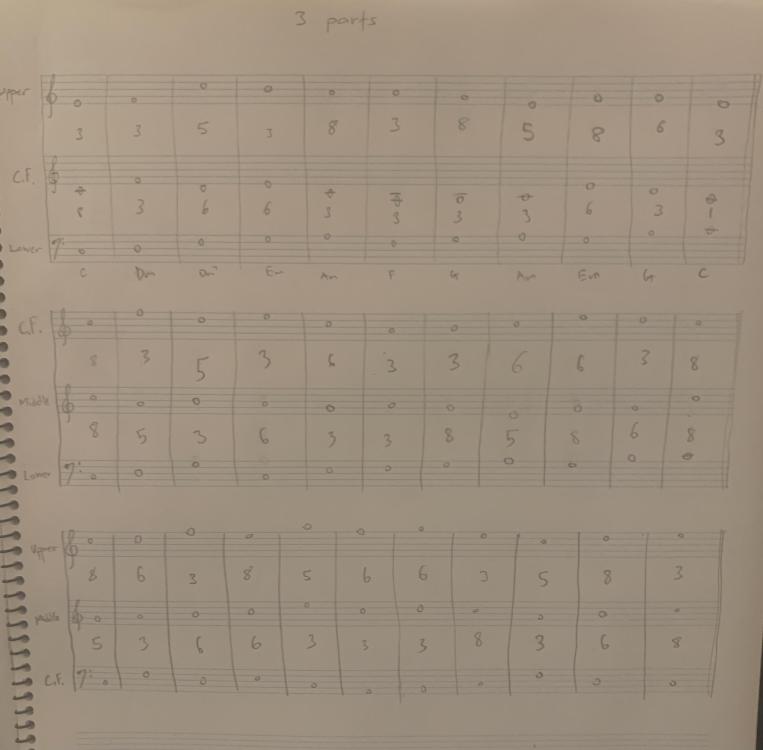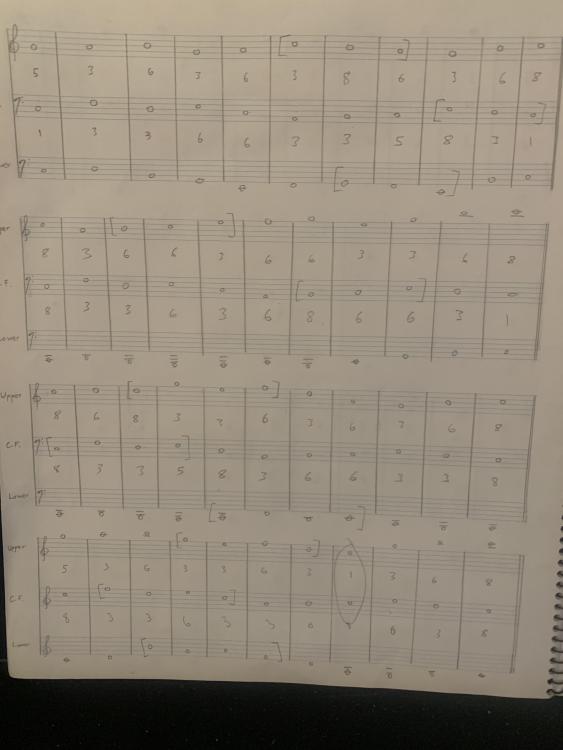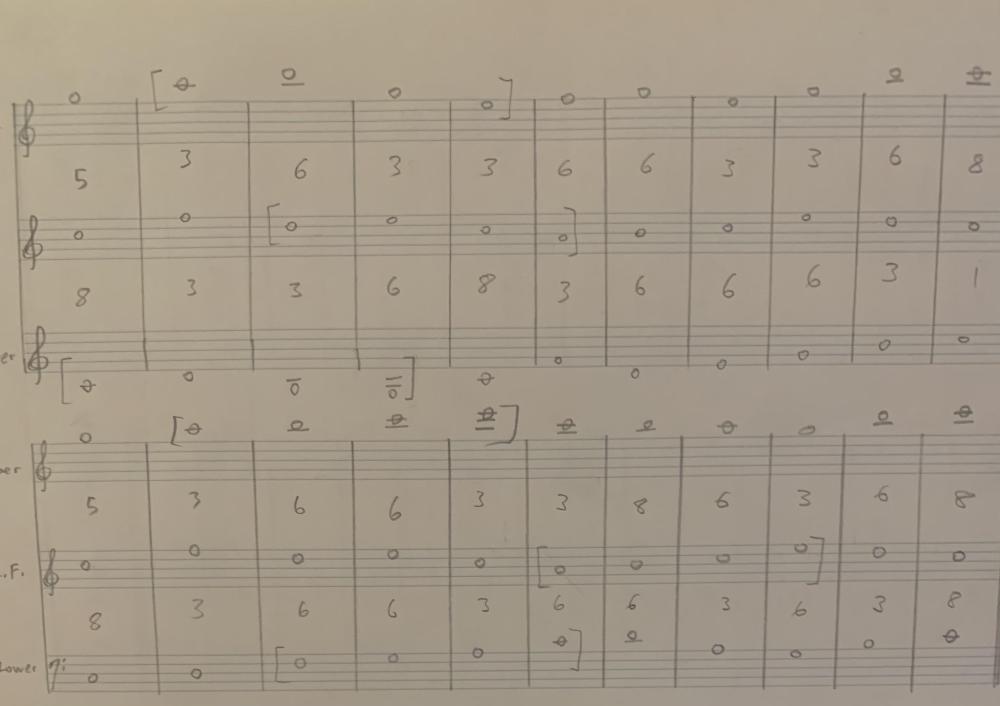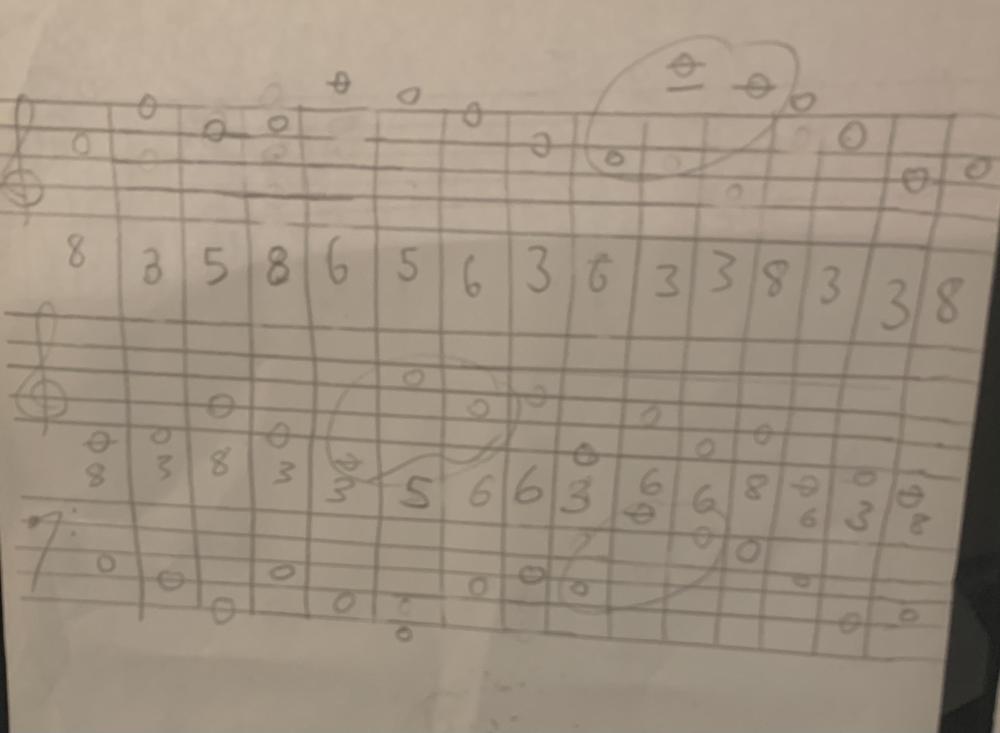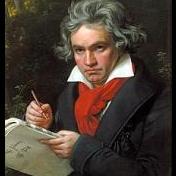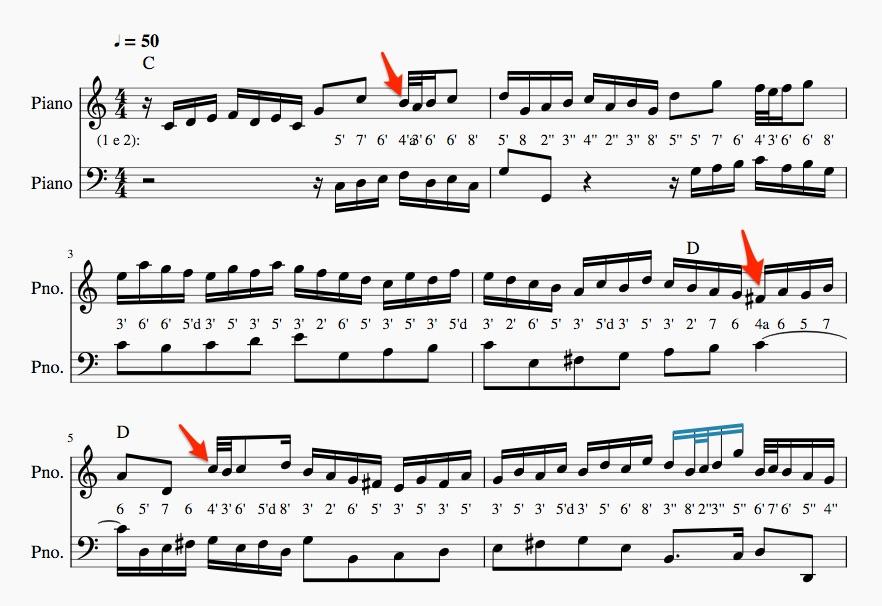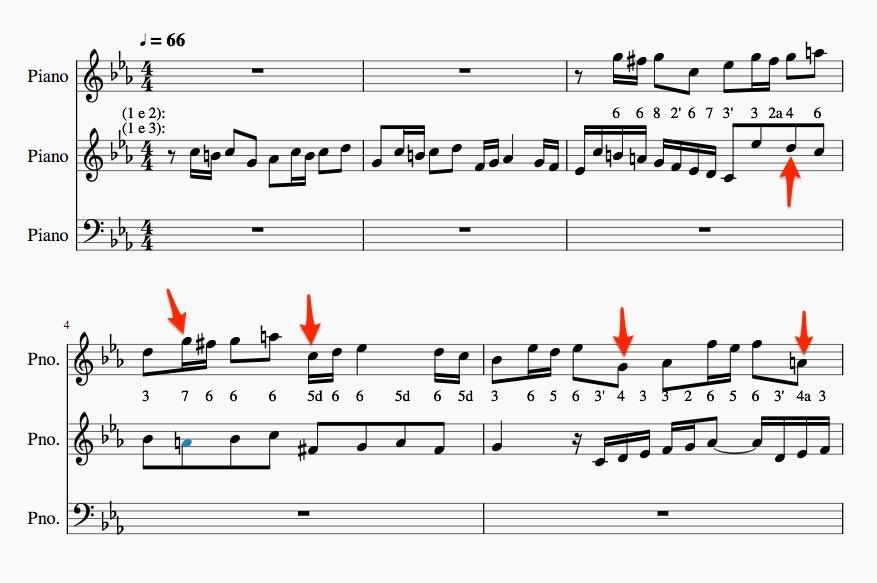Search the Community
Showing results for tags 'counterpoint'.
-
As implied by its title, this arrangement was based off my Crab Canon (aka. Canon Cancrizans) a 3 in C minor ( • Three-voice Crab Canon in B minor.): Since its initial publication, it has been transported one half step upwards to accomodate for the ranges of the instruments involved in this double trio, with the full realization played by the Continuo harpsichord part (which may be omitted entirely on account of the extremely wide intervals between voices in certain invertible configuartions making it rather difficult to play). Enjoy! YouTube video link:
- 5 replies
-
- 4
-

-
- counterpoint
- canon cancrizans
-
(and 2 more)
Tagged with:
-
Hi, I wanted some feedback on a basic Fugue I composed. I attached the pdf and Midi file
- 4 replies
-
- counterpoint
- composition
-
(and 1 more)
Tagged with:
-
This is my first fugue, I followed a structure given by Albrechtsberger’s. Some feedback will be appreciated, just note that this is my first fugue so it isn't the best. I'm looking to turn it into a keyboard fugue and need some help on that as well. Thank you Fugue - F major.pdf
- 4 replies
-
- composition
- feedback
-
(and 1 more)
Tagged with:
-
- 1 reply
-
- counterpoint
- harmony
-
(and 2 more)
Tagged with:
-
See the attached scores. I wrote two part 1st species counterpoint to a cantus firmus. I wrote one part above and below the cantus firmus for each exercise, note that they are not 3 parts but they are separate 2 parts, I did this to save space. I also included different motifs from the cantus firmus and imitated them in the other parts as shown in the square brackets. I added the intervals between the counterpoint and the cantus firmus Feedback will be greatly appreciated
-
counterpoint First Species Counterpoint Feedback
bhelloworld420 posted a topic in Advice and Techniques
Hi, I have just began writing first species counterpoint and want to get some feedback on it. I wrote four countermelodies for two upper cantus firmus and two lower. Any advice would be greatly appreciated First Species Counterpoint.pdf -
Hello Guys, This is my very first counterpoint attempt. It's just a brief piano piece. What do you think? The music sheet is an auto-generated one because I'm lazy...
-
Good evening everyone! I'm excited to present a new piece I have been working on for the last month or so: Scherzo for Orchestra. I deliberately wrote this fairly quickly, with the intent to write something fun, conventional, and maybe even a little whimsical. I'm interested in any and all constructive feedback. I had a few goals in mind as I composed this, feel free to critique my success or failure on these: Write something a little more informal and accessible, with catchy, memorable themes. Start with a very simple idea, and build the entire piece off of it. The four bar opening phrase in the 2nd violins popped into my head one day, so I tried to build the entire piece off of this motive and transformations of this motive. Practice having multiple contrapuntal lines. Some details on this are below. Write something that would work as a middle movement of a larger work, such as a symphony. Write something under 10 minutes, since I might decide to enter it into a competition and a lot of competitions have a 10 minute time limit. The piece is loosely structured in a three-part rondo form (ABACABA). (0:00 - 1:32) - A Theme - A very quick staccato theme in C# minor. I based this on the idea of a fugue, with each voice entering at different scale degrees, before they all come together to cadence. I'm sure I broke a few rules on the counterpoint, but it got the job done. The section ends on the V (G# minor) (1:32 - 2:21) - B Theme - A soaring theme in E major, then restated in Db major. Here I tried to have descending chromatic lines to complement the ascending melody. (2:21 - 3:04) - A Theme - Restatement of the second half of the A Theme, this time ending on I (C# minor) (3:04 - 6:31) - C Theme - A waltz in D major that begins very timid, gradually gains confidence, and goes out with a bang. (6:31 - 8:01) - A Theme - Restatement of the A Theme, this time in D minor, with the orchestration modified slightly. I threw in a couple unprepared modulations up a half step, to Eb minor and E minor. As a result I may have broken a "rule" here since I ended the section on B minor (which is not the V of D minor, the key I eventually return to). (8:01 - 8:49) - B Theme - Restatement of the B Theme, this time in Db major and Bb major. (8:49 - 9:37) - A Theme - The second half of the A Theme again, eventually returning to D minor to end the piece. As usual, I have an onslaught of questions I would like specific feedback on. Feel free to answer as many or as few as you wish: What effect does the music have on you? Does in conjure up an image? Or an emotional feeling? Does it tell you a story? This can be the piece as a whole, or a specific part or parts. What was your favorite part? What was your least favorite part? Do you have any comments or critiques on technique, e.g. harmony, melody writing, counterpoint, orchestration, voice-leading, etc.? How do you feel about the overall form? Is it effective? Do any of the parts seem impractical to you? It's a pretty fast piece with a lot of technique, so I'm curious if some of the parts are impractical. I don't mind them being difficult, I would only be concerned if they are borderline impossible. Do you have any comments of the quality of the performance in the audio file? I really want this to be a decent representation of how the piece would sound if it were performed live, since it is unlikely it ever will be. Feel free to put your "conductor hat" on and critique the "orchestra". I have included a score and welcome any constructive feedback on its presentation. And if you're like me it's a lot more fun to follow along with the score. Are there any composers this reminds you of, that I might enjoy listening to? Sound libraries: Spitfire Symphonic Orchestra and Spitfire Percussion VSL Trumpet (only for some of the lyrical trumpet melodies) VSL Violins (only to layer with the violins in Spitfire) Thanks for listening, I hope you enjoy! If you liked something I did and want me to explain how I did it, feel free to ask as well. -gmm
- 20 replies
-
- 9
-

-
- counterpoint
- scherzo
-
(and 2 more)
Tagged with:
-
Handel's "And With His Stripes We are Healed," but with my own contrapuntal addendums, twists, and best of all, vocaloid! Let me know what y'all think! The PDF below highlights all of my addendums
- 16 replies
-
- motet
- counterpoint
-
(and 1 more)
Tagged with:
-
Last Thursday was a special date for the history of Western music. 337 years ago, on the 31st of March, a child was born in Eisenach, a town located in Thuringia, modern-day Germany. His name was Johann Sebastian Bach, and he would become one of the greatest composers ever to live, even though most of his fame would be posthumous. Regardless, it has been of the utmost pleasure for me to dedicate one of my humble fugues to the birthday of Master Bach, in order to commemorate his art and work of such unfathomable abundance and heavenly quality as his spirit deserves. Link to the video:
- 3 replies
-
- fugue
- counterpoint
-
(and 1 more)
Tagged with:
-
For the last couple evenings I have invested most of my energy into finishing this fugue, which as shown below the title is coupled with an aphorism in Spanish, my native language: "Cuando cae el respeto a la muerte, decae la vida misma", which, leaving aside metaphorical extension, would roughly translate into English as "When respect to death is lost, so degenerates life." Even though said aphorism wasn't the main inspiration for this piece, I thought it was a nifty addition given the fatigue and withering emotions it was intended to wake on the listener. Since it is difficult for me to describe the nuances of this one as strictly "enjoyable", I guess the most appropriate closing expression for this one would perhaps be "feel existential" or something on those lines.
-
Composed between yesterday evening and today afternoon, as inspiration finally came forth amidst the silent darkness of tedious stagnation, bringing along a burst of renewed hopes and a dusty fugal subject from my earlier days, forsaken inside a long-unopened folder up until now. Also, happy 337th birthday to J.S. Bach! (If he could hear me from Heaven...) Link to the video:
-
After more than a year of inactivity in this forum, I've decided to return and paulatinely post my compositions from this period. Starting with my latest fugue, which as shown on the score PDF file was composed just two days ago and has undergone a key set of minor details being changed since I published it on my YT channel. Enjoy! Fugue in C minor #5.pdf
-
Trying to get some experience writing counterpoint. Constructive feedback is much appreciated!
-
First Fugue of my work "Colours of the Fugue". Enjoy and feel free to leave advice and any constructive criticism.
-
A second practice invention.
-
Fuga a 3 in g minor.mp3I recently have been reading and working through Jacob IJzerman's "Harmony, Counterpoint, Partimento" which I highly recommend, and I was inspired to write some short 3-voice fugues, mostly just to see if I could write them convincingly. Here's one of them. I scored it for flute oboe and bassoon so that the different parts could be heard easily.
- 4 replies
-
- 1
-

-
- baroque
- partimento
-
(and 3 more)
Tagged with:
-
Counterpoint is essential in my music (and it should be in general). I took some wonderful courses on counterpoint long ago, and they were essential in my personal musical development. I went into the idea of taking the basic concepts and use them in other styles. Fugue "a lo barroco" (baroque-style) is not my favourite field, but sometimes I do. it for fun, without that obsession about fifths and parallels, etc.... If it sounds good to me, it's OK. Three examples (the numbers is because they are part of a larger series): 08 Double Fugue in Ebm 11 Fugue in Fm (Doppo l'scuro nembo by Bellini) 19 Fugue in Am
-
Two-part invention. My first "serious" invention written after analysis of Bach's two-part inventions.
-
This is the first time that I improvised a fugue subject and multiple countersubjects and didn't immediately come across contrapuntal errors with my Check Harmony Rules plugin in Musescore. I haven't bothered to look more in depth though(like every note kind of depth). So there might be some errors that I missed. I want to resolve these before I move further with the fugue. As you can probably tell by the PDF file, I wrote this fugue exposition with the text of a Requiem in mind, specifically, the Introit, which is the first section of a Requiem mass. Augmented intervals, those most likely have to do with the leading tone combined with the minor key and thus, shouldn't be bothered with, right, so as to not stray away from the key too fast? Or are they unacceptable, even in minor keys? Here is the fugue exposition in image form, so as to highlight the Subject and 3 countersubjects: There, that is the fugue exposition. I figured that this Requiem fugue would be one of the best fugues for which the subject appearance order would be BTAS, or in other words ascending, to represent the ascent to heaven(I'm personally not religious, but I know some things about religion). Did I obey the counterpoint rules and write a good fugue exposition with 3 countersubjects? Or are there some errors that I missed? I mainly focused on not having parallel and direct octaves, fifths, and fourths, and not having too many parallel thirds or sixths, so I might have missed errors of unresolved dissonances and weak suspensions that did not get picked up on a first pass.
-
hello everyone, this is my first post, I am glad to have found this place! I am doing my species counterpoint believing that there would be few instances of broken rules in actual works. I thought that I would have to be very strict when writing a countersubject for example. Below are the beginning lines from invention 1 and fugue in c minor on which I have marked intervals that are "forbidden". How can I make the jump from strict species to actual writing? thank you in advance, Aristides.
-
Have you ever wanted to learn Baroque-style counterpoint? I am now offering counterpoint lessons over at NewBaroque for £40 / week. Here's the link: https://www.newbaroque.org/lessons/weekly The format of the lessons is one assignment every week (or every two weeks), which I'll mark and give you feedback on. Requests for specific exercises are welcome too.
-
I'm still not satisfied with my counterpoint, so I wrote these two little practice pieces. They're not mentioned for any instruments, but I had to choose something when making an mp3. Also, this is my first finished canon, that is I've written many canonical passages but this is my first standalone finished canon :D What do you think of these?
- 2 replies
-
- counterpoint
- canon
-
(and 1 more)
Tagged with:
-
Hi all! It's been a while since I've been on... and I'm returning with a question about Fux's counterpoint from Alfred Mann's The Study of Counterpoint: Are the solutions to each of Aloysius' examples (with corrections) the only acceptable solutions? In attempting to complete the very first exercise (first species counterpoint on the given cantus firmus, in the bottom voice, in dorian mode), I find there are good reasons to rule out most of the consonances that could be considered. However, I don't know if there are hard and fast rules which make the answers that Joseph gives the ONLY possible answers. Anyone have experience with this problem or insights? Thanks!
- 4 replies
-
- counterpoint
- voice leading
-
(and 4 more)
Tagged with:

